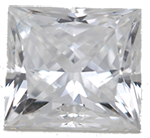We have a wide range
of eye clean diamonds
Eye Clean Diamonds and Face Up Eye Clean Diamonds
Considering The Clarity GradingMany customers understand that each diamond is unique, totally different to the next. This is one of the many aspects of diamond jewelry that makes them so special to own. Each diamond will have a different combination of color, carat weight, cut and clarity grading. One of the big factors making each diamond so different is the clarity grade. Typically, a diamond with an FL rating, meaning it contains no imperfections, otherwise known as inclusions, will cost far more than an SI2 graded diamond with similar characteristics. Some customers buying a diamond with a lower clarity grade will therefore ask a jeweler whether it is eye clean. What Does Eye Clean Mean?
Simply put, as the phrase suggests, eye clean in diamond terms means that inclusions can’t be seen in the diamond
with the naked eye. To know whether you are holding an eye clean diamond, assuming you have 20/20 vision, hold the
stone 6 – 12 inches away from you. You should do this under normal lighting conditions and ensure that the diamond
is being held at eye level.

Eye Clean Diamond Clarity Grades
Although there are exceptions, the rule of thumb is that diamonds that are SI1 graded or higher will usually be eye
clean, while some SI2 diamonds will also be eye clean. The main exceptions to this rule are step cut diamonds such
as emerald and asscher shaped diamonds; because their facets are arranged differently to brilliant cut diamonds,
such as round, oval and princess cuts, diamonds with a VS2 or higher clarity grade are most likely to be eye clean,
while some SI1 graded stones may also be eye clean.
 What Does Face Up Eye Clean Mean?After a diamond is set into a ring, you will always be looking at the table (the top) of the diamond. This is referred to as looking at a diamond face up. A diamond that is face up eye clean may well have imperfections visible to the naked eye if looked at from the pavilion (the bottom of the stone). An SI1 graded diamond, for example, may only be eye clean from the face up position, while SI2 graded diamonds will most likely not be eye clean at all. This video shows a great example of a 1.33 carat round diamond with J color and a clarity grading of SI1. The diamond would be considered eye clean because it has no easily-visible inclusions from the face up, although it is not eye clean when looking at the diamond from the pavilion. This video shows an IGL graded round cut 1.40 carat diamond with a color rating of J, an SI2 clarity and a very good cut grade. From the video you can see the difference between an SI1 graded diamond and an SI2 graded diamond. You may want to note, however, due to the special macro lens of the camera used to video this diamond, the imperfections are slightly more visible than they would be to the naked eye. Whether a diamond is eye clean or not also depends on the setting of the ring, pendant or stud earrings the ring is being set in. For example, many settings, such as the four-prong setting, may cover up imperfections along the sides of the stone. By taking factors such as this into account when choosing a diamond, you can save money by buying a diamond with a lower clarity grade that is nonetheless eye clean once it is in its setting. Should I Only Purchase Eye Clean Diamonds?The answer to this question depends on each customer’s requirements. Diamond that are not eye clean are still very popular for many reasons. Here are just three examples of cases where you may favor purchasing diamonds that are not eye clean.
If you have any questions about eye clean and face up eye clean diamonds, we can always be contacted on 1-800-557-7095 where one of our expert diamond jewelers will be happy to assist you. Alternatively, you can email us at [email protected] with any questions you may have. |


